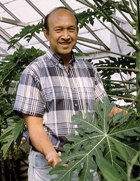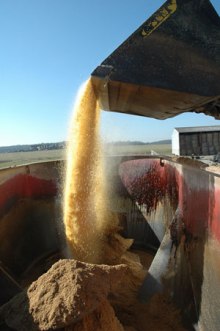
OGM : une solution à nos problèmes ? (2/3)
La technologie OGM peut-elle améliorer notre quotidien ? C’est ce qu’affirment en substance deux scientifiques dans leur communication. Dennis Gonsalves évoque l’exemple de la papaye OGM pour lutter contre un virus de cette plante détruisant les récoltes. Anthony Kinney développe quant à lui l’introduction d’oméga-3 dans certaines plantes, pour améliorer notre alimentation.
« Le monde végétal s'ouvre aux biotechnologies », tel était l'intitulé de ce colloque international les 15 et 16 septembre 2008 à l'Académie des sciences, rassemblant scientifiques, philosophe et cultivateurs.
La langue officielle était l'anglais, mais certains intervenants ont fait le choix de s'exprimer en français. C'est la raison pour laquelle vous trouverez les deux langues dans cette retransmission.
- Crop protection against viruses by GMO-based technologies / La protection des plantes contre les virus par technologies OGM
Dennis Gonsalves
US Pacific Basin Agricultural Research Center, USA

Dennis Gonsalves présente le développement, l'essai et la commercialisation de la papaye transgénique à Hawaï, ainsi que les efforts de transfert de cette technologie dans d’autres pays. C’est suite à un virus en 1992 qui réduisit à néant 98% de la papaye que les Hawaïen firent appel à la technologie OGM.
En 1985 déjà, des recherches transgéniques commençaient à être étudiés.
C’est en 1998, que les papayes transgéniques « lever du soleil » et « Rainbow » furent autorisées à être mises sur le marché.
Aujourd’hui, la papaye transgénique représente 80% de la production de papaye à Hawaï.
Le laboratoire qui a mis en place cette nouvelle espèce, travaille désormais avec la Jamaïque, le Brésil, le Vénézuela et la Thaïlande.

The approach of pathogen-derived resistance has been used to develop virus-resistant plants for 22 years, with much technical success with a large range of plant viruses and crops. For various reasons, however, only virus-resistant transgenic squash and papaya are actively grown commercially in the US, and none are commercially grown outside of the US. In both crops, the coat protein gene of the target viruses was inserted into the crop to provide resistance to watermelon mosaic Virus II and zucchini yellow mosaic virus in squash and papaya ringspot virus (PRSV) in papaya. This talk focuses on our experience with the development, testing, deregulation, and commercialization of the
transgenic papaya in Hawaii and our efforts at technology transfer to other countries. In May 1992, PRSV invaded the Puna area of Hawaii where 98% of the papaya were being grown. Fortunately, we
had started research to develop transgenic papaya for PRSV resistance in 1985. By 1992, we had identified a line of resistant transgenic papaya and initiated a field test with R0 clones. In the ensuing
six years, PRSV spread rapidly throughout the Puna area. By 1998, papaya production in Hawaii had been reduced by 50% as compared to 1992 levels.
In the mean time, the scientific team which
consisted of five researchers from University Hawaii, USDA, Cornell University, and the then Upjohn Company worked to field test the transgenic papaya, develop the transgenic line into commercial
cultivars, deregulate the transgenic papaya, and finally commercialize the transgenic papaya. All activities were done with very limited research funds. The transgenic ‘SunUp’ and ‘Rainbow’ PRSVresistant
cultivars were released for commercial planting in May 1998 and the reclamation of the devastated areas was successful. The resistance of the transgenic papaya is holding up and transgenic papaya now accounts for about 80% of papaya production in Hawaii. Our lab made similar efforts to develop transgenic papaya in cooperation with several countries, including Jamaica, Brazil, Venezuela, and Thailand. Transgenic papaya suitable for the collaborating countries were developed
and the transgenic lines have advanced to various levels. In particular, transgenic lines have been extensively tested under confined field conditions in Thailand with excellent results. However, so far
efforts by the Thailand Department of Agriculture at deregulation of the papaya in Thailand have not been successful. We are also applying for the deregulation of the Hawaiian transgenic papaya in Japan, which is a significant importer of papaya from Hawaii. Various factors that affect the
development and practical deployment of transgenic papaya will be discussed.
- Land-based source of nutritional fatty acids for the human diet /
Produire de manière durable les acides gras importants pour la nutrition humaine
Anthony J. Kinney
DuPont Experimental Station, USA
Beaucoup d’études ont montré que l'introduction d’oméga-3 pouvait avoir des effets positifs sur le plan cardiovasculaire et sur la santé mentale.
Aussi, les scientifiques s’activent pour « enrichir » du soja transgénique, mais aussi du lin et du colza en acides gras polyinsaturés, en s’appuyant pour cela sur la composition des huiles de poisson !
Explication : L'EPA et le DHA sont produits par des algues marines microscopiques qui sont consommées par les poissons. L’idée fut alors d’injecter ces gènes-clés à des plantes capables de synthétiser les acides gras oméga-3 dans leurs huiles de graine.
L'étape suivante consisterait à nourrir les animaux tels que la volaille et le bétail avec des plantes génétiquement modifiées afin qu'ils produisent de la viande, du lait et des oeufs enrichis en oméga-3.

Multiple studies have shown that inclusion of long chain omega-3 polyunsaturated fatty acids (LCPUFAs), especially EPA (eicosapentaenoic acid, 20:5) and DHA (docosahexaenoic acid, 22:6), in the human diet can have numerous health benefits including positive effects on cardiovascular and mental health. Fish oils are a rich source of EPA and DHA but there is growing demand for and declining wild fish stocks. In addition, fish oils have objectionable flavors and contaminants that are
difficult and cost-prohibitive to remove which limit the applications for fish oil in most foods. Oilseed plants engineered to produce EPA and DHA offer a safe, sustainable and cost-effective alternative to
fish oils as a source of LCPUFAs for food ingredients. Towards this end, we have placed novel EPA and DHA biosynthetic pathways into soybeans and other plants, and we have obtained significant amounts of these omega-3 LCPUFAs in the seed oil. The approaches used and recent advances made will be discussed.
En savoir plus :
- Ecoutez les autres intervenants de ce colloque :
-* OGM : domestication et amélioration des plantes (1/3)
-* Doit-on craindre les OGM pour notre santé ? (3/3)
-* Luc Ferry : les dangers du "principe de précaution"
- Ecoutez également notre émission : OGM : pour ou contre ? deux visions différentes de scientifiques
- Résumés des interventions et vidéos sur le site de l'Académie des sciences